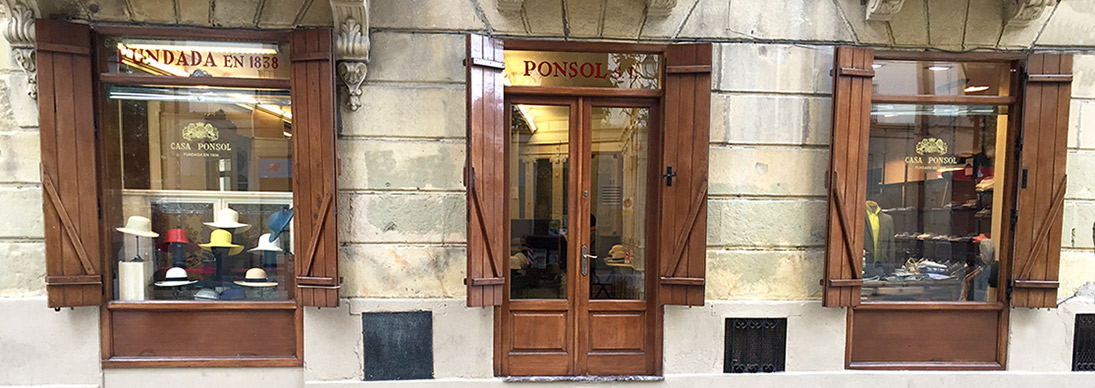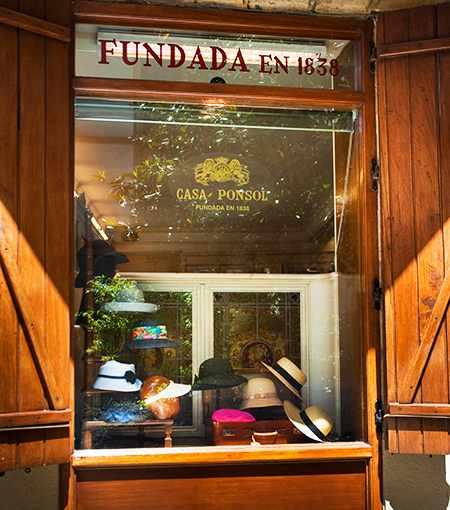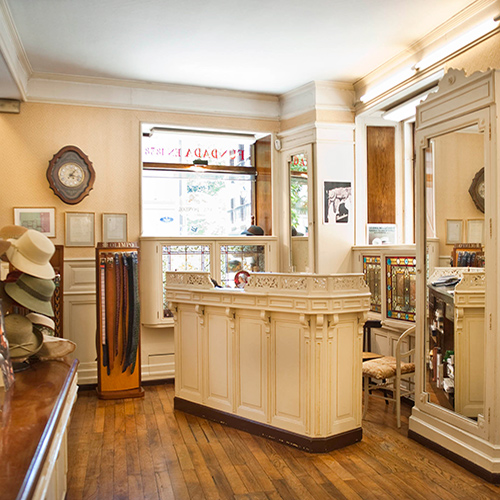Bernardo Ponsol who was originally from France, founded in 1838 at the same location as it remains today the Casa Ponsol (Ponsol’s House). It began as a hat shop that sold hats, berets and all kinds of headdresses for ladies. Founded so far back in time, Casa Ponsol it is without a doubt the eldest active shop in San Sebastian, the eldest hat shop in the Basque country and probably, the eldest hat shop in Spain.
When Casa Ponsol was being established, San Sebastian was hit by the First Carlist War which did not reach its end until the Convention of Vergara was signed in 1839.
By the time the Convention was signed San Sebastian had been under several devastating situations such as the Siege in 1813, when the city was captured by the Allied forces and the troops attack resulted in the ransacking and devastation of the town by a fire.
During the following years San Sebastian was rebuilt and the desired urban blossoming occurred. The city was positioned as one of the favourite destinations for royalty, aristocrats and distinguished people who were willing to enjoy not only the sunshine but also the therapeutic properties of the sea bathing. A clear example of that is, when the prince Francisco of Paula (brother of Fernando VII) and his wife Princess Luisa Carlota of Naples came with their children in order to enjoy the nine ritual baths on the beach.
View of San Sebastian, 1836. It shows the bridge made with barges possibly from the British Auxiliary Legion. This engraving belongs to the book “El Oasis: Viaje al País de los Fueros” by Juan Mañé Falquer, 1878.
During the first half of the nineteenth century, San Sebastian only had two hospitality establishments. One of them, Fonda Isabel (Isabel Inn), was located in the current Sarregui square, called at that time Schools square and popularly known as Higuera square (Fig tree square). In front of Fonda Isabel was the place where the stagecoaches were dropping off the passengers. In that same street there was also the post office…. It was undoubtedly a very good place to set up a business to cater and to deal with both: inhabitants and visitors.
After 1863 the city walls were demolished San Sebastian flourished and experienced a dramatic population increase. There were 9,000 inhabitants in 1860; 41,000 inhabitants in 1900 and more than 85,000 in 1930. Those years were also very good for Casa Ponsol that gained great prestige.
Around 1870, Agapito Ponsol Ybarzabal (Bernardo’s son) took over the family business after his father had passed away (around 1870). He was the city councillor who introduced and promoted the idea of planting Tamarinds at the Concha promenade. This affair was misunderstood at that time so, it caused him several disappointments. A few years latter though, as soon as the trees grew and started providing the desired shade, they became and still are one of the most recognized icons of San Sebastian and Agapito will always be remembered for this achievement.
At that time bathing was considered a very healthy habit. Conversely, the sun was not, therefore they used to cover their head with all sorts of hats or even with the classic and traditional berets. That belief was a goldmine for the millinery industry and trade which gained a great importance. Design, quality and fashion were the bench marks which provided fame to their owners.
Agapito was the berets master. As soon as a customer walked into his shop, had lost the possibility of choosing his own beret because was Agapito the one who decided everything. As if it were a ritual, he measured the head, chose the beret and placed it onto the customer’s head in the precise position. He was always right.
Queen Maria Cristina awarded Agapito Ponsol with the “Royal Household Supplier” title in 1897 as he was producing the berets that Alfonso XIII was wearing. Ponsol´s fame was recognized also in a well known French traveller’s guide. On it the French writer, E.Flagey in 1898, advised its readers about the purchase of souvenirs by saying the following: "To buy a beret I would go to Casa Ponsol, thirty steps from the Alameda. Because in San Sebastian is more than a tradition, it is an obligation to cover your head in Casa Ponsol”.
Mr. Ponsol took his apprenticeship in Paris, which taught him habits that afterwards served him to seduce his customers...
“The berets are sold from over 2 pesetas but the one I would strongly recommend is that one, which was sold for 7 pesetas, and today costs 6 pesetas that are exactly 3.5 francs ... The materials used are totally authentic. Not many businesses can add to their name the following words: reliable house”.
Is at this time when José Luis Leclercq y Uranga started to work with Agapito. José Luís was very young and his grandparents where from Belgium. He gained Ponsol´s confidence very fast. He gave him the opportunity to become supervisor and afterwards his business partner.
In 1922 Agapito died without any natural descendants so the business was taken over by José Leclercq who kept the original name: Casa Ponsol.
This Belle Époque business was advertised as “hats and caps of all kinds and renowned berets”. There were also sold “English raincoats, capes, ties, high quality knit waistcoats, travelling blankets and leather scarves, as it was stated in an advertisement of that time.
At the beginning of the century they had imported British presses and by 1914, fourteen milliners and ten skilled hat makers had been employed.
The establishment was always surrounded, at that time, by expert craftsmen from all over the world such as Achile Nordelste from Russia or Alphonse Duchene and Leoncio Capsenrox from France to name a few.
Casa Ponsol was the first hat shop in Spain where the famous “jipi-japas” hats were sold. Those were brought from very faraway places like Monte Cristil and Muyabamba, in America.
After the First World War, a new range of products started to be sold at the shop such as rainwear clothes, made with the Macintosh House Ltd. of Manchester materials. The capes of the guards were elaborated with these same materials too.
The business prospers and reaches its peak in the twenties boom with the boater fashion- canotier. With modern machinery a canotier-boater was produced in 30 seconds.
Leclercq married to Carmen Joseph Sarasola had six children. The sons, Jose Mari and Ignacio, widened their studies in France and England. José, the father, died in 1930. Ignacio and his sisters Karmele, Bitxori and Angeles continued in the primitive Casa Ponsol. Ignacio was a very popular person as he was a sportsman, a soccer referee, a French teacher at the Jesuits school as well as member of the Artisan Union, where he was Tambor Mayor (Major Drummer) for many years.
During the Civil War, the store was seized by the Falange, who used their infrastructure to produce military caps. As it was stated on the press: "Old Casa Ponsol, Army hats production, Spanish Falange and J.A.P (Youths of Popular Action). Berets for Requetés and renovation of all kind of hats". When the war ended, Leclercq’s family managed finally, to have their business back encountering throughout the process several difficulties.
Years go by and hat fashion declines, but Casa Ponsol managed to overcome these difficult stages, through hard work and imagination, maintaining the shop with the same aristocrat and distinguished style as in the old times and the current functionality.
In 1952, Iñaki Diaz Leclercq, Ignacio’s son, and his wife Pilar Garcia Zurbano took over the business and the shop that then languished, gained a new impulse.
They restored all the furniture as well as the magnificent glass windows which were badly damaged amongst the years. After the restoration, Casa Ponsol was one of the most beautiful shops in the city. After 1980, the hat started a significant recovery despite it did not have the same popularity as it had before. Casa Ponsol was selling at a part from hats, clothes for men. And it was still a city icon for fashion and quality as well as the favourite place for those who loved the traditional “txapela” (beret).
Nowadays, Iñaki García Leclercq (the fourth generation of the Leclercq’s family) is the person in charge of Casa Ponsol which is the eldest shop in San Sebastian. The whole saga Ponsol-Leclercq must be thanked for preserving the magnificent nineteenth-century decoration with the original desk, shelves and cabinets, as well as the splendid glass windows signed by "From Taffe, Bruxelles 1893". A true heritage for all “donostiarras” (San Sebastian citizens) those who wear a hat or not.

Outside of our shop.

